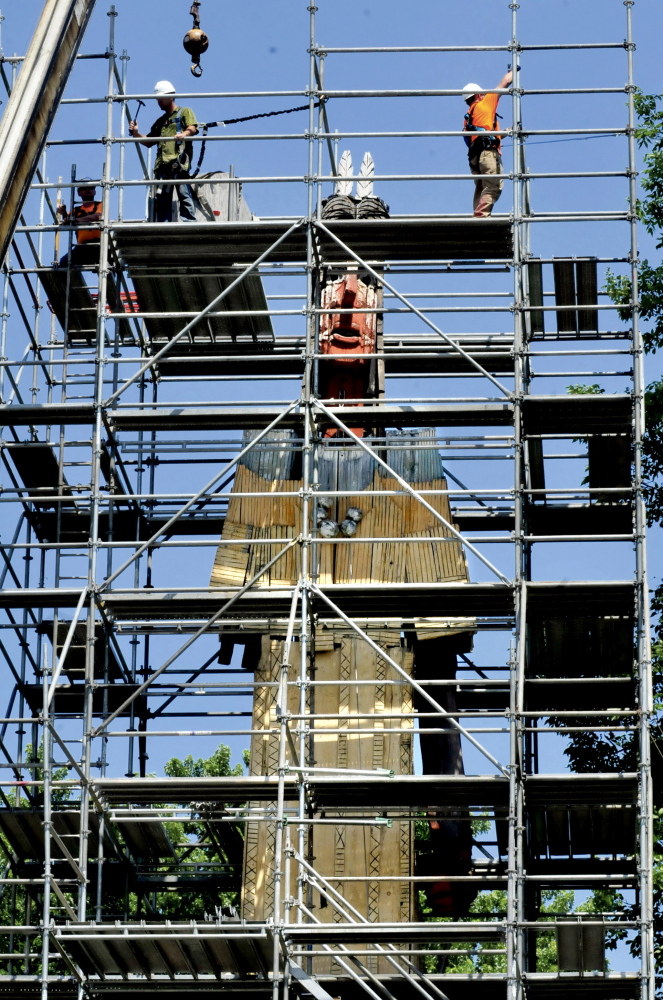SKOWHEGAN — Work got underway this week on the long-awaited restoration of the iconic Skowhegan Indian sculpture. Scaffolding has been erected, and workers have been climbing into position to begin restoring the 62-foot statue by the late Maine artist Bernard Langlais.
The Indian, completed by Langlais in 1969 as a tribute to Maine’s American Indian tribes, was made from carved sections of hemlock over a period of three years. The sculpture is owned by the Skowhegan Area Chamber of Commerce.
“It feels wonderful. It really does,” said Cory King, the Chamber’s executive director. “For so many years of talking about it, to see the work starting, it legitimizes our efforts and it lets people know this is really happening. It’s actually here.”
Work by Dionne and Son Builders, of Skowhegan, will continue through late August. The Chamber will hold an unveiling ceremony, currently scheduled for Sept. 13. Steve Dionne, who was hired to spearhead the restoration in 2006, said fundraising began in 2003 with a committee, which now has a Facebook page.
Dionne also bought the former Grange hall nearby with grist mill owner Amber Lambke and did the work of converting the 1865 Somerset County Jail into the Somerset Grist Mill and its associated businesses.
The cost of the Indian restoration — $65,000 — was raised through efforts by the Chamber, the Maine Community Foundation, the Maine Arts Commission, the Jackson Family Fund, Skowhegan taxpayers at last year’s annual Town Meeting, private donations and Main Street Skowhegan, a nonprofit downtown revitalization group.
“Scaffolding started going up on Monday,” said Dugan Murphy, executive director at Main Street Skowhegan. “I think that the restoration of Bernard Langlais’s Skowhegan Indian will prove to be a historically memorable turning point in our community. The fundraising effort represents a broad-based collaborative effort involving Main Street Skowhegan, the Skowhegan Area Chamber of Commerce, and so many more individual donors and volunteers.”
Langlais, who grew up in Old Town, was a student and teacher at the prestigious Skowhegan School of Painting & Sculpture. He died in 1977.
Billed as the world’s tallest statue of an American Indian, it borders land owned by Hight auto dealerships, Cumberland Farms, a doctor’s building and, by summer’s end, the new Variety Drug store.
The Indian’s original spear and fishing net have been removed from the sculpture and need to be replaced, as will the statue’s right arm.
Workers have covered holes in the main body of the statue, and a special solution was applied to the Indian’s legs, feet and other features to slow decay. The structure has a vertical steel beam secured to the 28-foot long concrete base and is stable, Dionne said. Stainless steel guy wires were installed to make it more stable.
Screening that was stapled to the sculpture’s underside to keep birds and squirrels out was only partially successful and will need to be replaced with stronger material, he said.
Paint samples were sent to a conservator in Virginia for analysis to replicate Langlais’ original work. Some trees that had grown up around the statue were taken down in June, making the statue more visible.
Margie Brown, of the local fundraising committee, said suggestions of possibly moving the Indian to another location was not a good idea because of the cost and because the sculpture is in the location where Langlais placed it, making the artwork more valuable.
Doug Harlow — 612-2367
Twitter: @Doug_Harlow
Send questions/comments to the editors.




Success. Please wait for the page to reload. If the page does not reload within 5 seconds, please refresh the page.
Enter your email and password to access comments.
Hi, to comment on stories you must . This profile is in addition to your subscription and website login.
Already have a commenting profile? .
Invalid username/password.
Please check your email to confirm and complete your registration.
Only subscribers are eligible to post comments. Please subscribe or login first for digital access. Here’s why.
Use the form below to reset your password. When you've submitted your account email, we will send an email with a reset code.